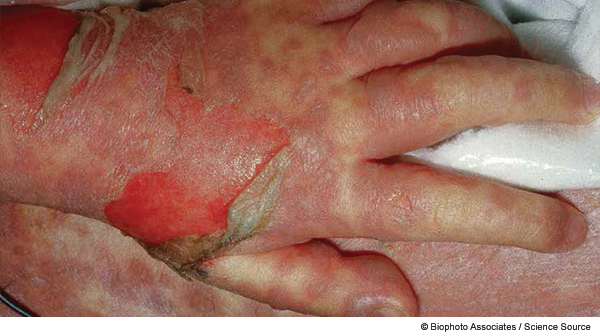
The Case
A previously healthy, fully immunized five-year-old boy presents to the pediatric emergency department with three days of fever and a progressive rash. Symptoms started with fevers to 104°F, a few “flat red spots” on his cheeks and behind his right ear, and bilateral injected eyes. The next day, he was seen by his primary doctor, who prescribed ofloxacin eyedrops for a presumed infection. That night, he developed crusting at his lips, redness and swelling of his palms and soles, and red patches on his trunk. On the morning of presentation, he had a few episodes of nonbloody, nonbilious emesis and complained of pain with urination and pain with swallowing. He was refusing to open his eyes to receive the prescribed medication.
Upon presentation to the ED, his blood pressure is 116/76, his pulse is 148, his temperature is 104.4°F, his respiratory rate is 21, and his SpO2 is 97 percent.
He is an alert, tearful boy, persistently keeping his eyes closed and clearly uncomfortable. There is left anterior cervical lymphadenopathy without a single large node and full range of motion at the neck. On ocular exam, the patient squeezes his eyelids shut and cries. Mildly edematous eyelids are pried open, and there is scant white/yellow discharge bilaterally. The pupils are equal and reactive to light, with bright red injection of the conjunctiva bilaterally. The lips are cracked and erythematous. There is a strawberry tongue and some desquamation at the buccal surfaces. There is tachycardia but no murmurs, rubs, or gallop with a brisk capillary refill. No respiratory distress is present. Abdominal and genitourinary exams are unremarkable for this circumcised male. There is mild bilateral hand swelling. There is an erythematous macular rash at the bilateral cheeks, chest, and back, as well as palmar erythema.
While in the ED, the patient is given a 40 cc/kg normal saline bolus, morphine, and acetaminophen, which make him more comfortable. He is started on maintenance IV fluids and ceftriaxone empirically. Vital signs normalize.
Background and Pathophysiology
Toxic epidermal necrolysis (TEN) is an infrequent medical emergency (0.4–1.3 cases per million per year worldwide) with high mortality.1 It is characterized by fever and widespread tender involvement of the epidermis and mucous membranes resulting in exfoliation. Stevens-Johnson syndrome (SJS) is categorized as less than 10 percent skin involvement, while TEN involves more than 30 percent of the body surface area. Both diseases are seen as a spectrum of a single process.2 Mortality is often due to systemic infection or multisystem organ failure.
Pages: 1 2 3 4 | Single Page





No Responses to “Recognize Pediatric Toxic Epidermal Necrolysis Symptoms, Manage Disease”